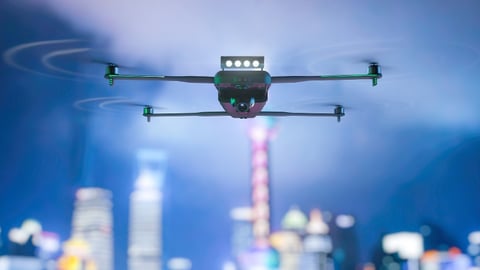Analysts say the drone motor market will grow to $7.3 billion by 2030. The projected growth rate of 28.4% for this decade tells us our remote-yet-global society has great need for powerful, reliable unmanned aerial vehicles (UAVs) and other drones.
Like any other aviation device, a drone’s design is a compromise between the motor, battery, controller, and other electronics -- and the cost of it all. Particular to the motor and battery, there are interesting, developing trends that could indicate a huge opportunity for someone to advance the industry.
5 Drone Motor Design Trends
These are the five drone motor design development and challenges that are most impacting engineers’ next moves:
- Battery range
- Frequency & core loss
- Torque & efficiency
- Motor setups & types
- Expanding applications
Battery Range
Any drone -- especially hobbyist models -- inherently has a short flight time due to the limited size of its mounted battery.
Larger batteries carry a higher range capacity, which can increase flight time. However, they also weigh more, which increases the thrust necessary for liftoff ... thus reducing battery efficiency. And we’re back at square one.
What if your UAV could go even 10% further? Just like with supercars, drone designers have been trying to optimize the balance of lightness and power for years.
Today, developers are still looking at everything possible for extending battery life -- from the battery itself to the motor, propellers, and electronic speed control (ESC) circuit.
Trend Alert -- Optimizing Internal Temperature Control: The silent killer of EV battery range is heat as a result of motor inefficiency. Using certain AC stator materials (to be revealed below) can improve efficiency and extend the drone’s operational range.
You may have blinked or cocked an eyebrow when we said “AC.” The simple brushed DC electric motor is tried-and-true, but modern users need greater flexibility, including more concise control of motor speeds and efficiency -- and, therefore, battery life. Consider this point also “to be continued below ...”
Frequency & Core Loss
Drone motors operate at high frequencies due to the need for small size combined with high output. Typical frequencies include 3,000-5,000 Hz, but there are plenty of high-performing models operating at up to 10,000 Hz.
What does this mean for that small drone motor? While a traditional high-frequency electric motor produces more efficiency at face value, the eddy currents increase dramatically. Remember -- that means this “more efficient motor” has to spend more effort cooling itself. Suddenly it’s caught in a cycle of inefficiency.
The source of frustration may be the electric motor’s material.
For AC motors, one traditional way of achieving lower losses with high-frequency magnetic materials is to use thinner electrical steel lamination sheets.
Why do laminations become problematic? You can only roll them so thin, and the price skyrockets as the sheet shrinks. Core losses in laminations also increase dramatically as you stack sheets.
Trend Alert -- Customizing Materials for Reduced Losses: Using soft magnetic composite (SMC) materials for AC motor speed and frequency control provides several benefits:
- Increased power efficiency from reduced core losses
- Lighter motor through improved torque density
- More cost-effective
Soft magnetic composites are highly customizable ferromagnetic powders coated with a uniform layer of electrically insulating film. The graph above shows that a popular SMC grade outperforms welded laminated M19 assemblies at frequencies as low as 60 Hz. Even an SMC rotor or stator of similar length to a lamination assembly will perform similarly to a much smaller SMC part.
Certain customized SMC grades can thrive at frequencies up to 10,000 Hz -- and beyond.
Torque vs. Speed
Reduction of power consumption is a key to increasing drone motor efficiency. But don’t forget about stability, too.
A bigger motor could certainly run more effectively, but we’ve already covered the drone’s need for a compact, mountable motor. To increase the output power, you could instead look at increasing torque or rotational speed of the motor.
High torque can provide the right amount of thrust from the motors and propellers to improve the drone’s:
- Liftoff ability
- Payload weight
- Stability
- Control
Drones are infamously unstable because they consist of at least four motors rotating at the same time. Recent stability control systems have corrected those issues somewhat, opening drones to a wider range of applications.
While high torque is often desirable, in drones you may be better off focusing on rotational speed performance. Why? Because more torque usually equals a bigger motor. If too heavy, the drone motor will rapidly lose torque after a certain period of use due to shrinking battery capacity.
Understanding your drone’s speed and torque requirements at each operational point can help you determine the appropriate motor design. Often in electric motor design, application requirements force the selection of a standard-but-oversized motor to ensure performance at all operational points. Unfortunately, this drives up weight and cost.
Increasing torque density may reduce motor weight, which in turn would allow UAVs (like surveillance and delivery drones) to carry a higher payload.
Trend Alert -- Balancing Speed With Torque (& Cost With Size): Fortunately, a little more customization can optimize a drone motor’s performance curves to precisely meet its specific needs. Some engineers are doing this by tweaking the motor’s electromagnetism -- either using more turns of smaller wire (for more torque) or fewer turns of larger wire (for more speed). Other engineers are adding gears to the motor output as a low-cost, low-size means of balancing speed and torque.
Motor Setups & Types
There are many ways to size up the state of drone motor manufacturing. Here are the more important notes from a designer’s standpoint:
Lower-Wattage Models
Forecasters estimate that 0-200 W power models will hold ~60% of the industry’s overall value opportunity in the 2020s. These are largely the low-end residential and hobbyist models.
Multirotor Drones
Multirotor drones earned more than 84% of the market share in 2020.
These devices consist of a central body with three, four, six, or eight rotors. The added rotors provide better control for the operator. The improved maneuverability allows multirotor drones to vertically take off or land in any space, making them a great fit for many applications.
Other benefits include reasonable price and higher payload than other drone types.
The more rotors on a drone, the more thrust it can generate. Additional rotors facilitate the creation of heavy-duty drones that can support industrial cameras or delivery payloads -- and other applications we’ll cover below.
The inevitable compromise is that each additional rotor requires additional current draw. Six- and eight-rotor designs will require more battery storage to achieve the same range as a four-rotor model.
Brushless DC Drone Motors
Brushless motors for drones are today’s standard, as brushed motors can only support the cheapest toy-grade models.
To be more specific, brushless DC drone motors are the most lucrative motor type in the worldwide drone market. These motors, typically of the permanent-magnet variety, can use either an outrunner or inrunner configuration.
An outrunner brushless configuration fixes the armature coils, with a ring of permanent magnets rotating around the coils. An inrunner design houses the rotating magnets inside the coils. Because an outer ring of magnets creates a larger air gap for the electromagnetic field to pass through, the outrunner method produces more torque.
One disadvantage of brushless DC motors is that they require constant optimization of speed and rotation direction, necessitating a motor driver. Drone motors must connect to a standalone electronic speed controller (ESC) to provide switching signals that properly manage rotational speed. The extra rigging can make DC drone motors pricier than AC alternatives.
The good news is that recent advances in brushless DC motor technology have led to the creation of sensorless motor drives, which will reduce those costs. Sensorless drives will also require fewer components, allowing the designer to shrink the motor’s size and maybe even increase its reliability.
Still, even today, brushless DC motors consume a lot of valuable energy in a drone, which can reduce its range. Which leads us to ...
Brushless AC Drone Motors (Permanent Magnet Synchronous)
Almost all drone motors are brushless. From there, it becomes a choice of AC vs. DC.
When designing a brushless drone, the decision between AC and DC typically comes down to your motor control algorithm of choice -- trapezoidal or field-oriented.
But since this article focuses mostly on the motor itself, let’s see where else we can dig up efficiencies ...
Traditionally, AC motors earn praise for their high power output and efficiency, while DC motors get all the love for their speed control and output range.
Trend Alert -- Greater Use of AC Motors: Here’s what you may not know -- the power of modern AC electric motor design can deliver cost, size, and weight savings while offering more precise control over energy use.
More specifically, what can AC permanent magnet motors using SMC materials offer?
- Cooler operating temperatures
- Longer potential lifespan
- Less power demand on start
- Precise acceleration and starting-current control
- Adjustable speed and torque
Expanding Applications
The ideas and breakthroughs above should help further the case of drones’ #1 fans: military/defense applications.
These specialized UAVs require high-performance batteries, motors, and manufacturing processes/materials for the ultimate results in reliability. After all, these devices must be able to operate in all weather conditions -- lives could be at stake.
The ability of multirotor drone designs to hover in place makes them ideal for surveillance and certain imaging applications -- not just in the defense industry, but others too.
All sorts of industries are getting in on the drone design craze:
- Scientific research -- including tracking & monitoring the spread of COVID-19
- Deliveries
- Inspections
- Agriculture
Of course, we can’t forget about the everyday consumer. Light, affordable, consumer-grade models can still benefit from the design possibilities discussed above. Demand is growing for reliable drone designs in a variety of household applications:
- Vacuums
- Pool cleaners
- Lawn mowers
Hub for Electric Motor Efficiency
The ultimate goal in drone motor design has been -- and will continue to be -- maintaining performance while shrinking size and weight. To reach new heights (or distances), engineers need to finally find that balance of frequency, torque, and other traits that impact range and efficiency. From there, the doors to new opportunities will swing even more wide open.
To learn more about the roles SMCs and sintered soft magnetic materials play in improving electric motor efficiency, check out our Engineers’ Hub:




